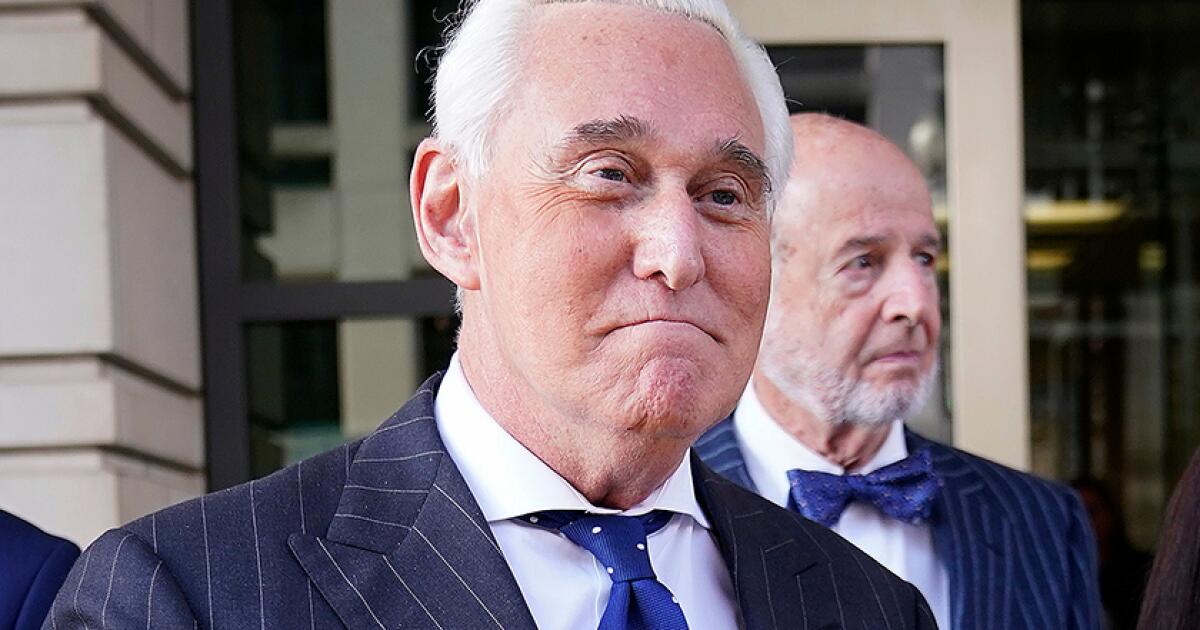Roger Stone sentencing seen as test of judicial independence
Roger Stone’s sentencing Thursday is shaping up as a test of judicial independence after President Trump inserted himself in the court’s deliberations over the fate of his longtime confidant.
If U.S. District Judge Amy Berman Jackson sentences Stone in line with the Justice Department’s new and lower recommendation, partisans will see that as caving to Trump, former federal prosecutor Harry Sandick said. If she gives a jail term closer to the maximum, she’ll be seen as defying the pressure.
“Given how polarized the country is, some people will look to Jackson to be a hero and give him a long sentence, and others will look to her to be a hero and give him a short sentence, but she’ll likely come in somewhere in between,” Sandick said. “She doesn’t need to be a hero. She’s a federal judge.”
Jackson said Wednesday that she’ll allow Stone to remain free regardless while she considers his bid for a new trial and any other motions filed after the sentencing. Speculation that sending him straight to prison could prompt Trump to swiftly pardon him rose after the president issued a slate of high-profile clemencies Tuesday in cases often supported by conservatives.
The Stone case stems from the U.S. investigation of Russian interference in the 2016 presidential election and was always politically charged. But it turned surreal last week when senior Justice Department officials overruled career prosecutors who had recommended a prison term as long as nine years. The rare step seemed a reaction to angry tweets by Trump. The prosecutors quit the case in response, and Trump mocked them afterward on Twitter.
The about-face over the sentencing recommendation prompted Democratic lawmakers to accuse Trump of using the Justice Department for his own bidding. It also set up a rare clash between the president and his attorney general, William P. Barr, who complained on television that Trump’s comments were harming the public perception of the Justice Department as impartial. Even the chief federal judge in Washington issued a statement affirming that public pressure wouldn’t affect sentencing decisions.
The four prosecutors who oversaw Stone’s case made a comprehensive argument about why he should be locked up for seven to nine years. It was based on sentencing guidelines and details of his case, including his combative and disruptive behavior during the court proceedings. Stone, 67, asked for no prison time at all.
The Justice Department said the line prosecutors didn’t calculate Stone’s offenses correctly and revised the sentencing recommendation to between three and four years. In his tweets, Trump called the original sentencing recommendation “a miscarriage of justice” and suggested the prosecutors behind it were minions of special counsel Robert S. Mueller III, whose probe of Russian interference in the 2016 election he has often derided as a corrupt “witch hunt.”
However she rules, Jackson may use the hearing to grill Justice Department lawyers about the decision-making behind the scenes, given how quickly the prosecutors who were most familiar with Stone’s case were overruled.
Jackson is “entitled to ask DOJ to explain in some way why they changed their position within 24 hours,” said Mimi Rocah, a former federal prosecutor in the Manhattan U.S. attorney’s office who’s running as a Democrat for Manhattan district attorney. “Judges are in charge when it comes to sentencing, so none of this would be out of the ordinary.”
Sharon L. McCarthy, a former federal prosecutor who’s now in private practice in New York, said Jackson could go so far as to ask Barr himself to appear.
“I think what has happened calls for that sort of drastic order,” McCarthy said.
Judges frequently hand down sentences that are lower — sometimes much lower — than what prosecutors suggest, and it’s possible that Jackson would have done so in Stone’s case even if Trump hadn’t weighed in or the Justice Department hadn’t reversed course. The perceived interference from the White House may complicate such a decision in Stone’s case.
Indeed, Trump’s commentary on the case could blow back on Stone if Jackson — who has also been criticized by Trump on Twitter — feels the need to demonstrate her independence by giving Stone a longer sentence than she otherwise would have, said Laurie Levenson, a former federal prosecutor who teaches at Loyola Law School.
“If Judge Jackson were inclined to give a lower sentence, that actually makes it harder for her to do so now,” Levenson said.
Jacob S. Frenkel, a former federal prosecutor and Securities and Exchange Commission trial attorney, said that “the irony of the president’s tweet is that it could end up backfiring.” The judge may decide “that to protect the integrity and project the independence of the judiciary, she may end up imposing a longer sentence than she may have originally intended,” Frenkel said.
Randall Jackson, a former assistant U.S. attorney in Manhattan who prosecuted Bernard Madoff, says the judge isn’t likely to adjust her sentence in response to Trump. Even so, he said, the furor that erupted over suspected interference by Trump and Barr could hurt Stone in court.
“A reasonable observer could question whether this is the type of thing that is going to distract the judge from what most defense attorneys would want the judge to be focused on, which is the mitigating factors for their client that could lead to a lower sentence,” Jackson said.

